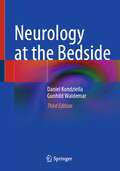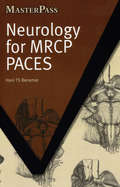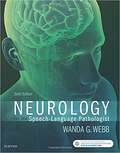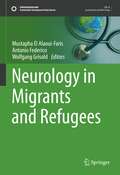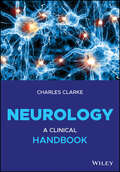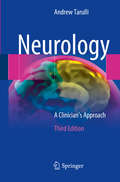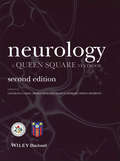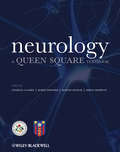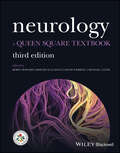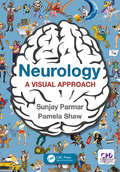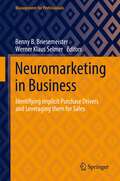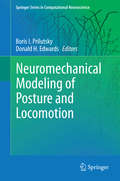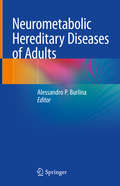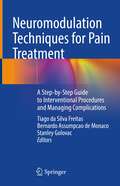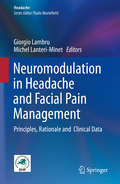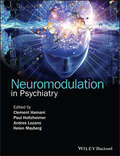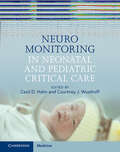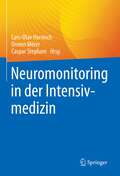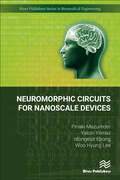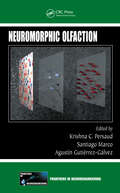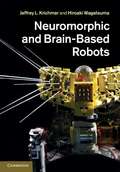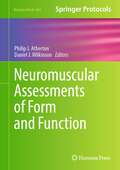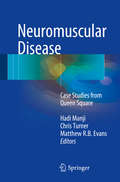- Table View
- List View
Neurology at the Bedside
by Daniel Kondziella Gunhild WaldemarNeurologists, perhaps more so than any other physicians, take pride in their bedside skills. Good clinical mentorship is mandatory in order to develop such skills; however, due to an ever-increasing need for more efficient working structures, the time and dedication that mentorship requires may not always be available. Neurology at the Bedside was written to fill this gap. Neurology at the Bedside addresses neurology residents looking for a personal clinical mentor. It takes them by the hand and guides them through the whole patient encounter—from an efficient neurological history according to neuroanatomical key features and the bedside examination to differential diagnosis, diagnostic procedures and lastly, the treatment. At each step Neurology at the Bedside points out what is essential and what is not. One of the most innovative areas in medicine, neurology is under rapid development with ever-increasing diagnostic and therapeutic opportunities. This exciting progress called for an update of the text. All chapters are thoroughly revised and reflect the essential state-of-the-art knowledge neurologists need to acquire during their training.
Neurology for MRCP PACES
by Hani TS BenamerNeurology has a reputation as a difficult area in the MRCP examinations, with the clinical neurology stations (PACES and traditional short cases) being especially feared by candidates. This book aims to demystify the subject, and help candidates avoid becoming bogged down in unnecessary detail and to clarify their thoughts and expression. The book is divided into three major sections covering areas of the body, each organised according to the possible instructions that candidates are likely to encounter in the exam. They include summaries of essential examination steps to be undertaken, possible clinical findings, brief discussions in question and answer format, and tips and pitfalls. Concise, clear and engaging, this is an essential aid for candidates preparing for the MRCP clinical neurology stations.
Neurology for the Speech-Language Pathologist (Sixth Edition)
by Wanda G. WebbThe concise, easy-to-understand Neurology for the Speech-Language Pathologist, 6th Edition provides students and clinicians with a practical guide for the study and understanding of neurology in speech-language pathology (SLP). Correlated with clinical syndromes and diseases seen in SLP, it gives you a solid understanding of the nervous system, including: development of the nervous system, organization of the brain, protective mechanisms, descending motor and ascending sensory pathways, and cranial nerves. New content, case studies, and a strong clinical focus make this new edition essential as you move into practice.
Neurology in Africa
by William P. Howlett Ellinor Moldeklev Hoff Christian BakkeThe distribution of neurological disease - and the resources available for its diagnosis and treatment - is very different in Africa. In addition, many of the diseases encountered, such as konzo, are poorly covered in standard Western textbooks on neurology and, with increased international travel, these conditions may be seen in clinics worldwide.<P><P> Neurology in Africa is written by William Howlett, a neurologist who has worked in Tanzania for almost twenty years. This book will be invaluable to trainees and practitioners in neurology and internal medicine working in Africa and neurologists travelling to Africa for work-placements. The content is highly practical and written in an easy style with clear, comprehensive explanations. The content covers clinical skills as well as guidance on the diagnosis and management of all the major neurological disorders. The book contains many line drawings, colour photographs, scans, tables and summaries of key points to aid understanding.
Neurology in Migrants and Refugees (Sustainable Development Goals Series)
by Wolfgang Grisold Mustapha El Alaoui-Faris Antonio FedericoThis book is the result of reflections and work of the Specialty group on neurology in migrants of the World Federation of Neurology. The volume provides a synthesis of migrants’ health in relation to the sustainable development goals and the 2030 agenda, and an up-to-date overview on neurological diseases among migrants, refugees and ethnic minorities.The book is composed of both general chapters dealing with the history of migration, the relationship between climate change and migration flows, the migration and neurosciences research and the barriers to migrant’s health. Other chapters deal with the migrants' particularities of the common neurological diseases such as cerebrovascular diseases, epilepsy, dementia, movement disorders, multiple sclerosis, headache, functional and mental disorders. In addition, also neurological manifestation of COVID-19 in ethnic minorities and palliative care in migrants are discussed.Neurology in Migrants and Refugees will be useful to neurologists worldwide who can find appropriate knowledge for diagnosis and treatment when facing migrants with neurological disorders which are sometimes difficult to assess in the absence of clinical experience with the migrant population. It will also be very useful for international organizations, policymakers and non-governmental organizations working in the field of health and migration.This book will certainly find an indispensable place in neurological departments libraries and will constitute a basic textbook for teaching neurology taking into account ethnicity, culture and health inequalities in the care of neurological disorders.
Neurology: A Clinical Handbook
by Charles Clarke“This Handbook is a sparkling addition to the neurological library, a concise and clear guide to clinical practice in neurology, written in elegant prose, a tribute to Queen Square and to the contribution that both Hospital and Institute have made to neurology. It is the encapsulation of wisdom gained in a long career. For practitioners in the art of neurology, junior and senior this is required reading." --Simon Shorvon, National Hospital for Neurology & Neurosurgery, Queen Square Neurology: A Clinical Handbook is a practical text, for both neurologists and general physicians, in the wards, the office or at home. This book spans the breadth of neurology and its challenges, for those who require a rapid resource in accessible language. The Handbook is also aimed at those considering entering neurology, neurophysiology and neurorehabilitation and for medical trainees and consultants in many specialities. It is an invaluable source for the MRCP, a ready-made reference for clinical practice and for the specialist nurse and therapist. The book deals with essentials - of neuroanatomy, clinical examination, mechanisms of neurological disease and the major issues of dementia and stroke in an ageing population. More specific aspects of neurology are also addressed, including the specialist fields of nerve and muscle disease, the spinal cord, headache and the cranial nerves, infection in the nervous system, MS and sleep disorders. The allied disciplines of neurorehabilitation, neuropsychiatry, neuro-oncology, uro-neurology, neuro-otology and neuro-ophthalmology are also covered. The aim is to provide both an introduction and a summary - of general neurological practice and the specialist aspects of neurology and neuroscience.
Neurology: A Clinician’s Approach (Blueprints Ser.)
by Andrew TarulliThis concise, thoroughly updated text provides a comprehensive, state-of-the art review of neurology and will serve as a highly practical resource for neurology residents and medical students. Emphasizing a practical approach to common neurologic disorders, the author blends chapters that cover the evaluation of specific complaints (confusion, dizziness and vertigo, visual loss, headache and facial pain) with others that focus on particular disorders (Parkinsonism, multiple sclerosis, dementia). Noting the core practice of neurology is largely unchanged from years ago and still largely done at the bedside, the author emphasizes the importance of acquiring expertise in the time-tested, classical techniques of history taking, directed examination, and localization. Toward that, the author encourages a focus on the key clinical pathways for diagnosis and management. A wide range of clinical pearls are provided and the diagrams and illustrations are well-designed and comprehensible, as are the clinical images (EEGs, CT, MRI) which provide excellent examples of a variety of neurologic disorders. The discussions and algorithms offered are evidence-based and state-of-the-art. Importantly, the author discusses a range of breakthroughs in the treatment of almost every disorder, with new medications available to treat amyotrophic lateral sclerosis, epilepsy, multiple sclerosis, and Parkinson’s disease, among others. Concise and well-written, Neurology: A Clinician’s Approach, 3rd Edition is an invaluable resource that will again serve as a very useful, gold-standard resource for trainees.
Neurology: A Queen Square Textbook
by Simon D. Shorvon Martin Rossor Charles Clarke Robin HowardNeurology: A Queen Square Textbook, second edition, is a fully revised and updated companion that demonstrates the rapid pace of advancement within clinical neurology and applied neurosciences A comprehensive and practical overview of current developments within clinical neurology, synthesising clinical neurology with translational research Expertly edited and written by neurologists, neuroscientists and neurosurgeons working at Queen Square, advised by an distinguished International Editor team to present a global perspective Introductory chapters summarise the basic sciences underpinning the practice of clinical neurology, including genetics, channelopathies, immunology, neurophysiology and neuropathology All chapters fully revised and updated to reflect the increasing role of neurologists in acute care Includes new contributions concerning major developments in the care of; stroke, epilepsy, dementia, Parkinson's disease, multiple sclerosis, neuromuscular disease, headache, infections, spinal disease, cranial nerve disease, neuropsychiatry, neurogenetics, neuro-oncology, uroneurology, neuro-otology, neuro-ophthalmology, pain medicine, sleep medicine, metabolic disease, drugs and toxins, autonomic disease, systemic disease, and neurorehabilitationfor dementia, epilepsy, headaches, neuro-genetics and many more
Neurology: A Queen Square Textbook
by Charles ClarkeNeurology: A Queen Square Textbook is a remarkable fusion of modern neuroscience with traditional neurology that will inform and intrigue trainee and experienced neurologists alike. Modern neuroscience has penetrated exciting and diverse frontiers into the causes, diagnosis, and treatment of neurological disease. Clinical neurology, whilst greatly enhanced by dramatic advances in molecular biology, genetics, neurochemistry and physiology, remains deeply rooted in practical traditions: the history from the patient and the elicitation of physical signs. Neurologists, neuroscientists and neurosurgeons working at Queen Square, and advised by an international editorial team, have combined their expertise and experience to produce this unique text. The synthesis of clinical neurology with translational research provides a fresh perspective which is Practical Multidisciplinary Translational Integrative The blend of new science and proven practice underpins this creative approach towards investigating and improving the care of patients suffering from neurological diseases. About Queen Square The world-renowned National Hospital for Neurology & Neurosurgery and UCL Institute of Neurology, based in Queen Square, London, have an international reputation for training, research and patient care. Research at both institutions leads developments in translational medicine that are transforming the treatment of neurological disease.
Neurology: A Queen Square Textbook
by David Werring Robin Howard Michael Zandi Dimitri Kullmannneurology A fully updated and authoritative neurology resource The Queen Square Textbook has established itself as a favourite companion to clinical neurosciences training and teaching around the world, whilst retaining its role as an invaluable reference guide for physicians and other healthcare professionals working in neurology, general medicine and related specialties. The book continues to reflect the core values essential to the practice of clinical neurology in the 21st century. The third edition has been extensively revised and updated to take account of the rapid pace of progress in the neurosciences and patient care. Contemporary neurology has been changed by the COVID-19 pandemic, the climate emergency and the growing inequalities in healthcare resources. The new edition has been extensively revised to reflect these challenges and affords a greater emphasis on management and rehabilitation whilst continuing to reflect the coherence of a text produced from a single, closely-knit, centre of excellence. Highlights of the new edition include: An updated approach to clinical examination, decision-making and diagnosis New developments in neuroimmunology, pathology and genetics Neuropalliative care Ethical and legal issues in clinical neurology The latest developments in the understanding and management of stroke, movement disorders, epilepsy, cognitive impairment, multiple sclerosis, infections, myelopathy, anterior horn cell disease, disorders of nerve and muscle, neuro-oncology, neurological disorders of hearing, balance and vision, and the neurological care of critical illness, sleep, neuropsychiatry, pain, autonomic and urological disorders. An emphasis on treatment and rehabilitation of the person with a neurological disease The new edition marks a significant transition to reflect contemporary neurological practice during uncertain times. It mirrors the enormous changes in investigation, diagnosis and treatment that have occurred in recent years whilst maintaining the underlying principle that we do not treat diagnoses but, rather, we care for people affected by neurological disease.
Neurology: A Visual Approach
by Sunjay ParmarThis brand-new revision aid has been designed specifically to help medical students and early post-graduate doctors learn and remember pertinent information about various neurological conditions through pictorial representation, and will be invaluable throughout medical studies and particularly useful in the pressured run-up to final and post-graduate examinations. <P><P>The highly-structured information is presented in a consistent, double-page format. Each condition is represented by a characterful and memorable visual mnemonic, accompanied by a concise, high-yield review covering definition, aetiology, epidemiology, presentation, investigation, management, complications and prognosis. Over 40 common conditions are included, organized alphabetically for ease of reference. <P><P>Neurology is often viewed as a challenging subject to learn. By utilising visual imagery to aid memory and recall of important information, the author brings a refreshing new approach to knowledge consolidation.
Neuromarketing in Business: Identifying Implicit Purchase Drivers and Leveraging them for Sales (Management for Professionals)
by Werner Klaus Selmer Benny B. BriesemeisterThis book shows how neuromarketing works in practice. It describes how companies can use the methods and insights of neuroscience to make better decisions themselves. It brings together real-world use cases in the area of applied neuroscience, collected from the globally leading consumer neuroscience companies and their clients. The use cases come from a variety of business areas, from advertising research to store design, from finding the right name for a brand to designing a compelling website. The book reveals how clients engage in neuromarketing; the business problems they can encounter, and have encountered, solving with this new approach; and the values they generate.
Neuromechanical Modeling of Posture and Locomotion
by Boris I. Prilutsky Donald H. EdwardsNeuromechanics is a new, quickly growing field of neuroscience research that merges neurophysiology, biomechanics and motor control and aims at understanding living systems and their elements through interactions between their neural and mechanical dynamic properties. Although research in Neuromechanics is not limited by computational approaches, neuromechanical modeling is a powerful tool that allows for integration of massive knowledge gained in the past several decades in organization of motion related brain and spinal cord activity, various body sensors and reflex pathways, muscle mechanical and physiological properties and detailed quantitative morphology of musculoskeletal systems. Recent work in neuromechanical modeling has demonstrated advantages of such an integrative approach and led to discoveries of new emergent properties of neuromechanical systems. Neuromechanical Modeling of Posture and Locomotion will cover a wide range of topics from theoretical studies linking the organization of reflex pathways and central pattern generating circuits with morphology and mechanics of the musculoskeletal system (Burkholder; Nichols; Shevtsova et al. ) to detailed neuromechanical models of postural and locomotor control (Bunderson; Edwards, Marking et al. , Ting). Furthermore, uniquely diverse modeling approaches will be presented in the book including a theoretical dynamic analysis of locomotor phase transitions (Spardy and Rubin), a hybrid computational modeling that allows for in vivo interactions between parts of a living organism and a computer model (Edwards et al. ), a physical neuromechanical model of the human locomotor system (Lewis), and others.
Neurometabolic Hereditary Diseases of Adults
by Alessandro P. BurlinaThis practical book describes only neurometabolic hereditary diseases which have a specific treatment and encourages the general neurologist to think of the most common neurometabolic hereditary diseases, which he might have seen and never considered in the differential diagnosis. Information regarding how to deal with diseases with special therapy is provided (i.e. enzymatic replacement therapy in Fabry disease and Pompe disease), as is information on diseases which are not easily recognized (i.e. Niemann-Pick disease type C), and diseases with clinical features mimicking other common neurodegenrative diseases (i.e. Wilson's disease). Neurometabolic Hereditary Diseases is written with a clinical focus for adult neurologists working in general hospitals.
Neuromodulation Techniques for Pain Treatment: A Step-by-Step Guide to Interventional Procedures and Managing Complications
by Stanley Golovac Tiago da Silva Freitas Bernardo Assumpcao de MonacoNeuromodulation implants are currently one of the most successful techniques in the treatment of chronic pain, a condition that affects more and more patients each year, leading to reduced quality of life as well as economic losses.Neuromodulation implants for pain are a relatively new technique and are being increasingly used around the globe. However, technical training is not available for every implanter as there are relatively few centers in the world. Further, refresher courses for low-rate implanters are not available. This book fills that gap by offering an update on the best techniques currently used, providing a step-by-step guide on how to perform these procedures correctly. Based on the experiences of leading physicians in the field, it also discusses how to manage both major and minor complications. Lastly, it covers the neuromodulatory intervention techniques used to treat chronic pain in various clinical areas. As such it is a valuable resource for pain physicians as well as neurosurgeons, orthopedists and anesthetists.
Neuromodulation in Headache and Facial Pain Management: Principles, Rationale and Clinical Data (Headache)
by Giorgio Lambru Michel Lanteri-MinetThis book addresses all aspects of neuromodulation therapy in the management of headache and facial pain disorders, paying particular attention to the application of this rapidly growing and fascinating therapy to different forms of headache and facial pain conditions. It is divided into sections covering the principles of and rationale behind neuromodulation for headache, including in-depth discussions of challenging topics such as the definition of refractory headache and prognostic factors, and the technical aspects of devices used to modulate peripheral and central neuronal targets for the management of headaches. In addition, the book reviews the state-of-the art in current neuromodulation practice for headaches, discusses therapeutic strategies and therapy selection for each headache and facial pain disorder, and presents an in-depth, critical analysis of the published evidence, with sections covering innovative devices and emerging applications of novel neuromodulation technologies in the field. Gathering papers by internationally respected, leading experts, the book offers a unique guide to neuromodulation therapies in headache for neurologists, pain specialists, neurosurgeons, neuroscientists, trainees and general practitioners with an interest in headache and facial pain management.
Neuromodulation in Psychiatry
by Clement Hamani Helen Mayberg Paul Holtzheimer Andres M LozanoEdited by an expert multidisciplinary team, Neuromodulation in Psychiatry is the first reference guide to address both invasive and non-invasive neuromodulation strategies used in psychiatry. Covers basic principles, technical aspects, clinical applications and ethical considerations Presents up-to-date evidence in comprehensive summaries suitable for all levels of experience Each technique is clearly explained along with its implications for real-world clinical practice Allows psychiatrists to make informed decisions regarding neuromodulation for their patients
Neuromonitoring in Neonatal and Pediatric Critical Care
by Cecil Hahn Courtney WusthoffDemand for neuromonitoring in neonatal, pediatric and cardiac intensive care units continues to grow, motivated by increased awareness of the high prevalence of seizures among critically ill neonates and children, and emerging evidence that these seizures can contribute to brain injury. This book provides physicians, nurses and trainees caring for critically ill newborns and children with a practical overview of how to use and interpret continuous neuromonitoring to enhance patient care. Authored by international experts from diverse institutions and professional backgrounds, this is a practical guide that is accessible to intensive care specialists, but also comprehensive enough to serve as a reference book for neurologists and neurophysiologists. Concise enough to be read cover-to-cover and illustrated with over thirty case-based examples, this authoritative reference will guide readers in accurate neuromonitoring interpretation and optimal use of conventional EEG, amplitude-integrated EEG and other quantitative EEG techniques.
Neuromonitoring in der Intensivmedizin
by Lars-Olav Harnisch Onnen Mörer Caspar StephaniBei zahlreichen Intensivpatienten ist ein neurologisches Monitoring unabdingbar. Die kontinuierliche Überwachung erlaubt eine frühzeitige Diagnose und Therapie und ist neben der klinischen Beurteilung des Patienten für die optimale Versorgung essenziell. Das Buch gibt reich bebildert und mit zahlreichen Tabellen einen umfassenden Überblick über die gängigen Neuromonitoring-Verfahren in der Intensivmedizin, wie Elektroenzephalographie, Nahinfrarotspektroskopie, intrazerebrale Druckmessung, zerebrale Mikrodialyse und Hirngewebssauerstoffgehaltsmessung. Es zeigt darüber hinaus, welche Methoden bei welchen Bewusstseinszuständen und Krankheitsbildern am sinnvollsten eingesetzt werden, z.B. zur Überwachung der Sedierungstiefe, bei Schädel-Hirn-Trauma, bei unklarer Vigilanzstörung, nach Reanimation oder zur Hirntoddiagnostik. Auch bei der Interpretation der Befunde hilft das Werk und leistet damit wertvolle Unterstützung für die bestmögliche Diagnose und Therapie. Das Werk wendet sich an alle Ärztinnen und Ärzte auf Intensivstationen, die ein differenziertes Neuromonitoring verstehen und korrekt einsetzen möchten.
Neuromorphic Circuits for Nanoscale Devices
by Pinaki Mazumder Yalcin Yilmaz Idongesit EbongNanoscale devices attracted significant research effort from the industry and academia due to their operation principals being based on different physical properties which provide advantages in the design of certain classes of circuits over conventional CMOS transistors. Neuromorphic Circuits for Nanoscale Devices contains recent research papers presented in various international conferences and journals to provide insight into how the operational principles of the nanoscale devices can be utilized for the design of neuromorphic circuits for various applications of non-volatile memory, neural network training/learning, and image processing. The topics discussed in the book include:Nanoscale Crossbar Memory DesignQ-Learning and Value Iteration using Nanoscale DevicesImage Processing and Computer Vision Applications for Nanoscale DevicesNanoscale Devices based Cellular Nonlinear/Neural Networks
Neuromorphic Olfaction
by Santiago Marco Krishna C. Persaud Agustín Gutiérrez-GálvezMany advances have been made in the last decade in the understanding of the computational principles underlying olfactory system functioning. Neuromorphic Olfaction is a collaboration among European researchers who, through NEUROCHEM (Fp7-Grant Agreement Number 216916)-a challenging and innovative European-funded project-introduce novel computing p
Neuromorphic and Brain-Based Robots
by Hiroaki Wagatsuma Jeffrey KrichmarNeuromorphic and brain-based robotics have enormous potential for furthering our understanding of the brain. By embodying models of the brain on robotic platforms, researchers can investigate the roots of biological intelligence and work towards the development of truly intelligent machines. This book provides a broad introduction to this groundbreaking area for researchers from a wide range of fields, from engineering to neuroscience. Case studies explore how robots are being used in current research, including a whisker system that allows a robot to sense its environment and neurally inspired navigation systems that show impressive mapping results. Looking to the future, several chapters consider the development of cognitive, or even conscious robots that display the adaptability and intelligence of biological organisms. Finally, the ethical implications of intelligent robots are explored, from morality and Asimov's three laws to the question of whether robots have rights.
Neuromorphic and Brain-Based Robots
by Hiroaki Wagatsuma Jeffrey L. KrichmarNeuromorphic and brain-based robotics have enormous potential for furthering our understanding of the brain. By embodying models of the brain on robotic platforms, researchers can investigate the roots of biological intelligence and work towards the development of truly intelligent machines. This book provides a broad introduction to this groundbreaking area for researchers from a wide range of fields, from engineering to neuroscience. Case studies explore how robots are being used in current research, including a whisker system that allows a robot to sense its environment and neurally inspired navigation systems that show impressive mapping results. Looking to the future, several chapters consider the development of cognitive, or even conscious robots that display the adaptability and intelligence of biological organisms. Finally, the ethical implications of intelligent robots are explored, from morality and Asimov's three laws to the question of whether robots have rights.
Neuromuscular Assessments of Form and Function (Neuromethods #204)
by Philip J. Atherton Daniel J. WilkinsonThis volume looks at the latest methods used to study imaging techniques, metabolic tracing, and deep muscle phenotyping. The chapters in this book cover topics such as imaging skeletal muscle mass using MRI, dual-energy x-ray absorptiometry, CT, and ultrasound; measures of neuromuscular function such as power/strength/force; microscopy and immunohistochemistry; and ex vivo fibre function and isolation. In the Neuromethods series style, chapters include the kind of detail and key advice from the specialists needed to get successful results in your laboratory. Comprehensive and thorough, Neuromuscular Assessments of Form and Function is a valuable resource for researchers interested in multiple methods used to study skeletal muscle neurophysiology.
Neuromuscular Disease
by Chris Turner Hadi Manji Matthew R. B. EvansThis book provides an accessible guide to neuromusculardisorders using case scenarios from the world-renowned MRC Centre forNeuromuscular Diseases at the National Hospital, Queen Square, London, UK. Fiftygenetic and acquired disorders are presented in a practical, easy-to-readformat, including those that are common and also some which are rare. Each case covers the history, examination andinvestigations, including neurophysiology, neuroradiology and neuropathology ifappropriate. Discussions of each case include the differential diagnosis,useful clinical pointers and a brief summary of the management of thecondition. Neuromuscular Disease:Case Studies from Queen Square is aimed at neurology trainees andconsultant general neurologists.
